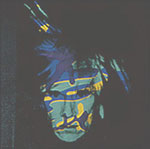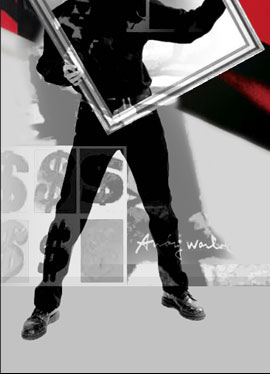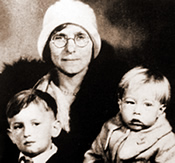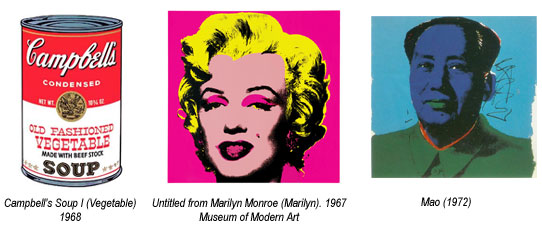


Assignment
Background
Timeline
WWW Sites
Recommended Books
Related Events

Self-Portrait, 1986

 Assignment:
Assignment:
To what extent did Warhol and the Pop art movement simultaneously affect and reflect changes in popular culture in the 2nd half of the 20th century?
 Background:
Background:
Andy Warhol (1928-1987) was an essential contributor to the Pop art movement of the 1950s and a widely respected icon in the gay community. Pop art was a new style of art which began in England in the 1950s which utilized realistic renditions of popular, everyday items. Warhol’s pop art pieces are well-known cultural icons of the 20th century. Some of his most widely recognized pieces are celebrity portraits, Campbell soup cans, and his many films.

Andy Warhol, Artist, New York City, August 14, 1969, 1969
Portrait by Richard Avedon
Andy Warhol, born Andrew Warhola, was born to Czechoslovakian immigrant parents in Pittsburgh on August 6, 1928. He was the youngest of three children. From a young age, Warhol discovered his love of art, which he shared with his mother who encouraged his artistic development. As a young child growing up, Warhol had to deal with low self esteem issues and social awkwardness. He contracted a disease known as St. Vitus' dance (chorea, a disease that attacks the nervous system and makes someone shake uncontrollably). This, in addition to his pale blotchy skin and white blond hair made Warhol somewhat of an outcast.

Young Andy (right) with his mother and brother, 1931
After high school, Warhol attended and received his degree from Carnegie Institute of Technology with a major in pictorial design. Through his fine art studies at CIT Warhol developed his blotted-line technique (two pieces of blank paper are taped together with ink drawn of a single page and then pressed together before the ink dries to create irregular lines that are then colored with watercolors). After college, Warhol moved to New York in the 50s where he began to be recognized for advertisements using the blotted-line technique for Tiffany & Co., I. Miller, and Vanderbilt’s Complete Book of Etiquette
 .
.
Pop Art, the popular movement influenced by mass media, advertising, comics, and consumer products began in Britain in the 1950s and was joined by American artists such as Jasper Johns and Robert Rauschenberg. Warhol followed and made his movement into Pop Art in the 60s. He began with paintings of Coke bottles and comic strips, but finally made his name to fame with his paintings of Campbell’s soup cans. With the desire to produce paintings faster, Warhol moved on to using the process of silk-screening (a process by which silk is used to create a pattern/stencil which can be reproduced over and over again). The silk-screened portraits of celebrities such as Marilyn Monroe and Chairman Mao of China became some of his most recognized works.

Through the 60s Warhol continued with his silk-screened paintings and his films. His works, both paintings and films, were primarily aimed at getting the viewer to look at something for longer than they otherwise would, in addition to blurring the differences between what was considered high art and low art.. Through his works Warhol attempted to reflect on the consumerist nature of society. Celebrities and fame, to Warhol, were considered the height of modern consumerism. He was often quoted saying “In the future every person will be famous for fifteen minutes.”
 Timeline:
Timeline:
August 6, 1928 – Andrew Warhola is born in Pennsylvania
Fall 1936 – Warhol falls ills with chorea
1945 – Warhol begins his studies at Carnegie Institute of Technology
1949 – Warhol moves to New York City
1952 – Warhol has his first exhibition in NYC titled Fifteen Drawings
Based on the Writings of Truman Capote
1962 – Warhol gets his first solo Pop Exhibition of 32 different
canvases of Campbell's soup cans and The Factory is created (Warhol's
studio)
1962 – Warhol creates his first silkscreens
1968 – Warhol is shot by a disgruntled actress, although not killed,
he is permanently weakened
February 21, 1987 – Warhol dies of heart failure following a gall
bladder surgery at the age of 58
 WWW
Sites:
WWW
Sites:
The sites most dedicated to the works of Andy Warhol are The Andy Warhol Museum (official site of the Andy Warhol Museum in Pittsburgh, PA.), Warholsters (Site about Andy Warhol and his circle of friends/artists/celebrities) and The Andy Warhol Foundation for the Visual Arts.
Additional sites include:
The Artcyclopedia which includes links to museums and galleries showing Warhol's works in addition to a listing of additional resources on Warhol and his works.
The Artchive which gives an overview on Pop Art in addition to showcasing the major artists associated with the movement.
Artnet where you can view available works of art, prices and exhibitions by the Warhol in galleries worldwide
For a list of Pop-Artists see www.popartists.com/ or wwar.com/masters/movements/pop_art.html
GLBTQ's (an encyclopedia of gay, lesbian, bisexual, transgender, and queer culture) view of Pop Art.
An analysis of Pop Art and Warhol's contribution from the Christian Science Monitor.
Pop art and it's relation to today's culture from Forbes Magazine.
Read about British Pop Art vs. American Pop Art.
Experiment with the colors of Warhol's famous Marilyn screen print from this Color, Vision, and Art Web Exhibit.
Biographies on Andy Warhol from The Lucid Cafe, Artelino.com and Artchive. See also AndyWarholeposters.com for a biography and pictures of his work.
 Recommended
Books:
Recommended
Books:
For more information on Andy Warhol see:
Lise Kaiser, Steingrim Laursen, and Andy Warhol, Andy Warhol and
His World (Louisiana, 2001)
British Film Institute (Corporate Author), Andy Warhol Museum (Corporate
Author), Who is Andy Warhol (British Film Institute 1998)
Reva Wolf, Andy Warhol, Poetry, and Gossip in the 1960s
(Chicago 1997)
John O'Connor and Benjamin Liu, Unseen Warhol
Andy Warhol and Pat Hackett, The Andy Warhol Diaries
(Warner Books 1991)
For more information on Pop Art see:
Jim Edwards, David E. Brauer, Christopher Finch, Walter Hopps, Pop
Art (Hatje Cantz Publishers 2001)
Lucy R. Lippard, Pop Art (1985)
Steven Henry Madoff, Pop Art: A Critical History (The Documents
of Twentieth-Century Art) (California 1997)
Marco Livingstone, Pop Art: A Continuing History (2000)
 Related
Events:
Related
Events:
|
This page is copyright
© 2005, C.T. Evans and K. Schilling |